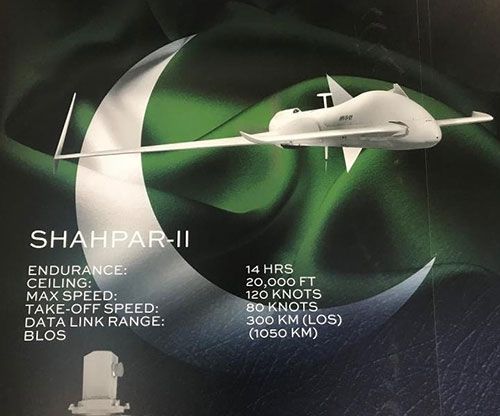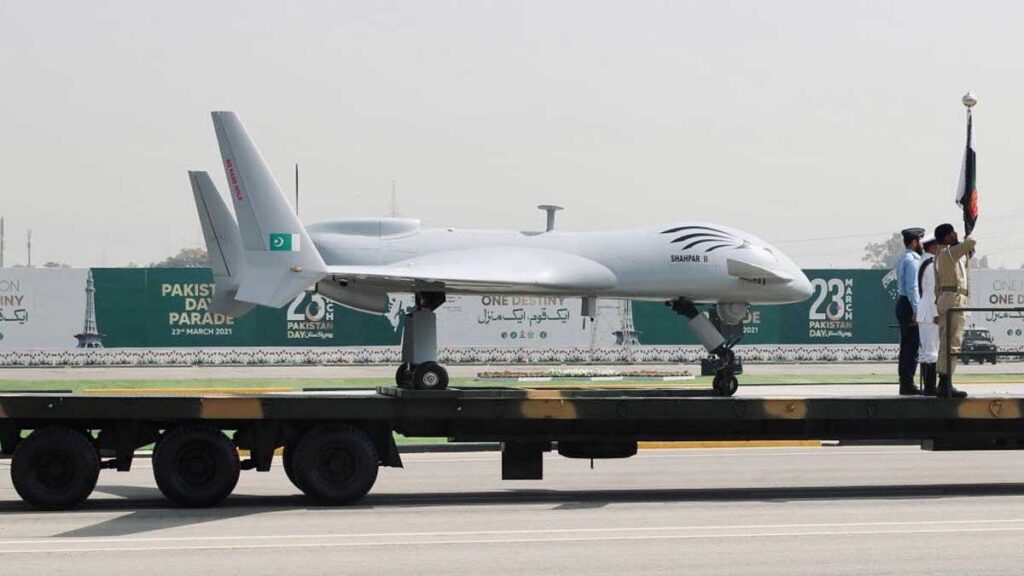
Pakistan’s Global Industrial & Defence Solutions (GIDS) showcased its new armed Unmanned Aerial Vehicle (UAV), the Shahpar-II, at the Egypt Defence Expo (EDEX) which took place in Cairo from 29 November to 02 December 2021, local media reported.
The Shahpar-II is a medium-altitude long-endurance (MALE) UAV developed by the National Engineering and Scientific Commission (NESCOM). NESCOM/GIDS are marketing the Shahpar-II as a multi-mission UAV capable of targeted strikes, surveillance, and an array of intelligence-gathering roles.

An evolution of NESCOM’s Shahpar UAV, the Shahpar-II is a larger and longer-ranged design. GIDS, which is the marketing arm of various Pakistani state-owned enterprises (SOE), revealed that the Shahpar-II was in development since at least 2017. NESCOM officially revealed the Shahpar-II at the 2021 Pakistan Day Military Parade, which took place on March 23. It seems that the Pakistani armed forces are inducting the Shahpar-II, but they are also comfortable with allocating production for export as well.
The Shahpar-II’s airframe is a canard-pusher design. In its surveillance configuration, the Shahpar-II has a service ceiling of 20,000 ft and endurance of 14 hours. In its attack configuration, the Shahpar-II provides a service ceiling of 18,000 ft and an endurance of 7 hours. When using satellite communication (SATCOM), the Shahpar-II can fly a range of up to 1,050 km. However, with a standard line-of-sight radio link, the Shahpar-II offers a range of up to 300 km. It seems that Pakistan is offering both options for export.
GIDS did not disclose the actual payload capacity of the UAV, but it revealed that the Shahpar-II can carry a Burq laser-guided air-to-ground missile (AGM) on each wing. It can carry an alternative AGM weighing up to 60 kg. It is not known if the Shahpar-II can employ multiple munitions from each wing if the weight of those systems stayed under the 60 kg limit. However, if capable of that configuration, then the Shahpar-II could theoretically carry miniature guided munitions like Roketsan’s MAM-C, which weighs 6.5 kg.
The Shahpar-II can offer a variety of configurations for intelligence, surveillance, and reconnaissance (ISR) roles. These include communications intelligence (COMINT), electronic intelligence (ELINT), and synthetic aperture radar (SAR). The Shahpar-II can also carry an electro-optical and infrared (EO/IR) turret. In fact, GIDS is offering the domestically-built Zumr-II, which weighs 49 kg.
Based on GIDS’ information, Pakistan’s ‘standard’ configuration of one Zumr-II EO/IR turret and two Burq AGMs would indicate a minimum carrying capacity of 170 kg. If accurate, this would make the Shahpar-II comparable to the Turkish Bayraktar TB2, which has a carrying capacity of over 150 kg. In fact, both UAVs are broadly similar in their respective capabilities (though the TB2 has a markedly higher service ceiling). There are even indications that the Shahpar-II offers some of the same key features as the TB2, including an automated take-off and landing system (which Pakistan has been developing).








1 Trackback / Pingback